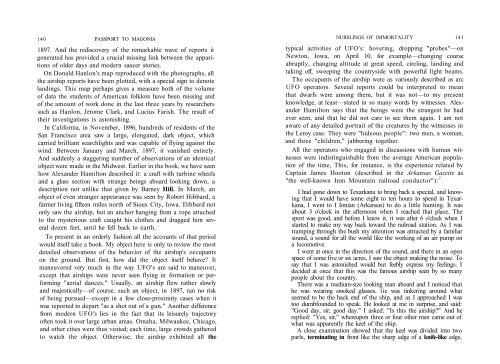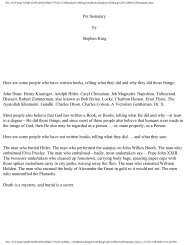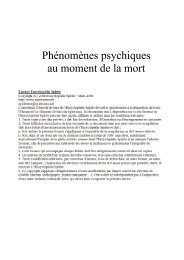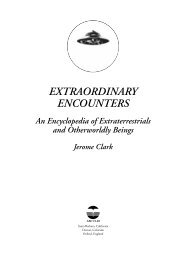Create successful ePaper yourself
Turn your PDF publications into a flip-book with our unique Google optimized e-Paper software.
140 PASSPORT TO MAGONIA<br />
1897. And the rediscovery of the remarkable wave of reports it<br />
generated has provided a crucial missing link between the apparitions<br />
of older days and modern saucer stories.<br />
On Donald Hanlon's map reproduced with the photographs, all<br />
the airship reports have been plotted, with a special sign to denote<br />
landings. This map perhaps gives a measure both of the volume<br />
of data the students of American folklore have been missing and<br />
of the amount of work done in the last three years by researchers<br />
such as Hanlon, Jerome Clark, and Lucius Farish. The result of<br />
their investigations is astonishing.<br />
In California, in November, 1896, hundreds of residents of the<br />
San Francisco area saw a large, elongated, dark object, which<br />
carried brilliant searchlights and was capable of flying against the<br />
wind. Between January and March, 1897, it vanished entirely.<br />
And suddenly a staggering number of observations of an identical<br />
object were made in the Midwest. Earlier in the book, we have seen<br />
how Alexander Hamilton described it: a craft with turbine wheels<br />
and a glass section with strange beings aboard looking down, a<br />
description not unlike that given by Barney Hill. In March, an<br />
object of even stranger appearance was seen by Robert Hibbard, a<br />
farmer living fifteen miles north of Sioux City, Iowa. Ilibbard not<br />
only saw the airship, but an anchor hanging from a rope attached<br />
to the mysterious craft caught his clothes and dragged him several<br />
dozen feet, until he fell back to earth.<br />
To present in an orderly fashion all the accounts of that period<br />
would itself take a book. My object here is only to review the most<br />
detailed observations of the behavior of the airship's occupants<br />
on the ground. But first, how did the object itself behave? It<br />
maneuvered very much in the way UFO's are said to maneuver,<br />
except that airships were never seen flying in formation or performing<br />
"aerial dances." Usually, an airship flew rather slowly<br />
and majestically—of course, such an object, in 1897, ran no risk<br />
of being pursued—except in a few close-proximity cases when it<br />
was reported to depart "as a shot out of a gun." Another difference<br />
from modern UFO's lies in the fact that its leisurely trajectory<br />
often took it over large urban areas. Omaha, Milwaukee, Chicago,<br />
and other cities were thus visited; each time, large crowds gathered<br />
to watch the object. Otherwise, the airship exhibited all the<br />
NURSLINGS OF IMMORTALITY 141<br />
typical activities of UFO's: hovering, dropping "probes"—on<br />
Newton, Iowa, on April 10, for example—changing course<br />
abruptly, changing altitude at great speed, circling, landing and<br />
taking off, sweeping the countryside with powerful light beams.<br />
The occupants of the airship were as variously described as arc<br />
UFO operators. Several reports could be interpreted to mean<br />
that dwarfs were among them, but it was not—to my present<br />
knowledge, at least—stated in so many words by witnesses. Alexander<br />
Hamilton says that the beings were the strangest he had<br />
ever seen, and that he did not care to sec them again. I am not<br />
aware of any detailed portrait of the creatures by the witnesses in<br />
the Leroy case. They were "hideous people": two men, a woman,<br />
and three "children," jabbering together.<br />
All the operators who engaged in discussions with human witnesses<br />
were indistinguishable from the average American population<br />
of the time, This, for instance, is the experience related by<br />
Captain James Hooton (described in the Arkansas Gazette as<br />
"the well-known Iron Mountain railroad conductor"): 7<br />
I had gone down to Texarkana to bring back a special, and knowing<br />
that I would have some eight to ten hours to spend in Texarkana,<br />
I went to I Ionian (Arkansas) to do a little hunting. It was<br />
about 3 o'clock in the afternoon when I reached that place. The<br />
sport was good, and before I knew it, it was after 6 o'clock when I<br />
started to make my way back toward the railroad station. As I was<br />
tramping through the bush my attention was attracted by a familiar<br />
sound, a sound for all the world like the working of an air pump on<br />
a locomotive.<br />
I went at once in the direction of the sound, and there in an open<br />
space of some five or six acres, I saw the object making the noise. To<br />
say that I was astonished would but feebly express my feelings. I<br />
decided at once that this was the famous airship seen by so many<br />
people about the country.<br />
There was a medium-size looking man aboard and I noticed that<br />
he was wearing smoked glasses. lie was tinkering around what<br />
seemed to be the hack end of the ship, and as I approached I was<br />
too dumbfounded to speak. He looked at me in surprise, and said:<br />
"Good day, sir; good day." I asked: "Is this the airship?" And he<br />
replied: "Yes, sir," whereupon three or four other men came out of<br />
what was apparently the keel of the ship.<br />
A close examination showed that the keel was divided into two<br />
parls, terminating in front like the sharp edge of a knife-like edge,





